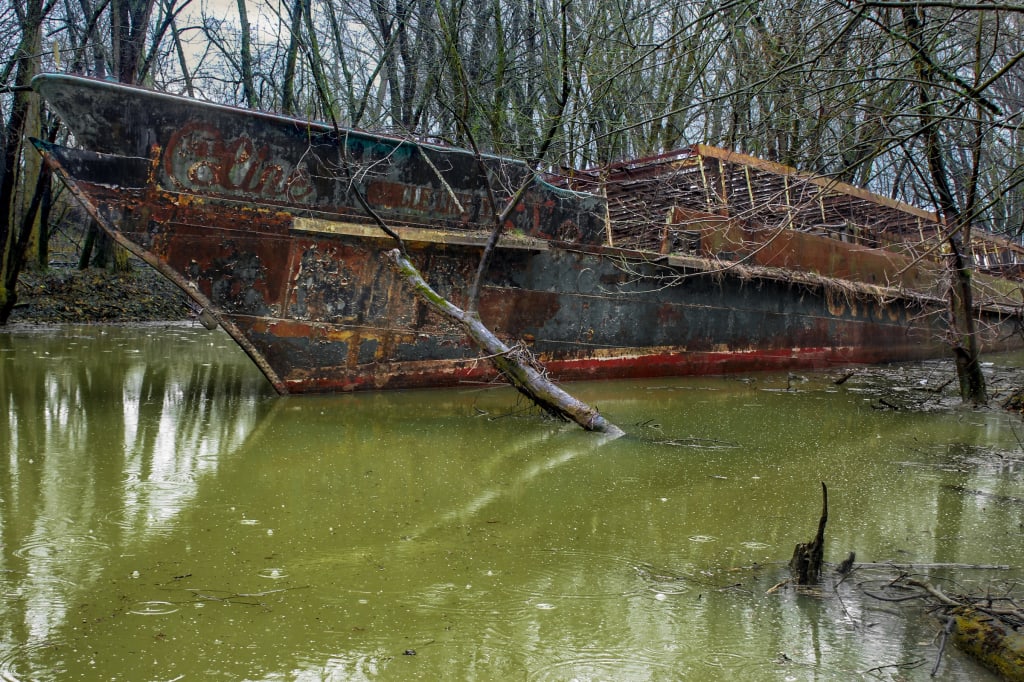The Ghost Ship of Kentucky
It has become something of a roadside attraction for the town, although its current state doesn’t give justice to its storybook past.

Petersburg, Kentucky isn’t known for much. Aside from the divisive Creation Museum, “a cathedral of willingness ignorance” as one TripAdvisior reviewer wrote, it’s a quintessential small town. Well, it’s not even a town but an “incorporated community,” and there isn’t much drawing tourists here. Paranormal experts and lookie-loos alike put this community on their map because of a supposedly haunted abandoned ship run aground in a backwoods river. The ship blips through the history pages like a nautical Forrest Gump, hosting Edison, Madonna, and two presidents, in addition to helping the fight in both world wars.
On the bank of a murky Kentucky inlet called Taylor Creek, the ship lays abandoned for the past few decades, camouflaged by the thick forest. The eerie greenish water trickles by year after year, slowly rusting this forgotten piece of history. As rain drizzles down, soft metallic clangs fill the air. Water floods the lower levels, gradually reclaiming it for nature. Once a yacht, research station, warship, tourist vessel, now but a dismal contrast to its former grandeur.
I read about this ship on a forum about haunted places in Kentucky. Although, besides it looking creepy, no one could seem to come to any consensus on why it might be haunted. Some blogs claimed a little girl drowned after falling overboard. However, this seems to be a lie for the sake of a good story.
Looking for the boat led me to Petersburg, down several curvy roads barely wide enough to get by, and stomping through the brush on the muddy bank of the creek. Trees jutted out of the water, giving it the semblance of a Louisiana swamp. After a short walk, I spotted it through the brush that hid it from the road. Dead trees surrounded the deck and branches stretched toward its sides but never quite reached. It was beautiful and unsettling. With rising water levels due to recent rains, I realized the only way to get aboard is by canoe, which I didn’t have.
It couldn’t be reached from land anymore without getting very wet. So I set all my important items on the driest ground I could find and tentatively waded through the brown river water, trying not to let the late February cold get to me. Quickly, I was up to my neck. I doggy-paddled a dozen feet to the back side entrance and hoisted myself aboard.
I peeked into the few rooms that weren’t completely flooded from the recent rain. Metal creaked and groaned with every cautious footstep. Grass and weeds crept through the floor and along the handrails. The few interior rooms were bare and rusted. It was hard to imagine this bygone skeleton was ever anything great. The floor was riddled with holes where it had caved in, showing the dark, partially-submerged interior. It was congested with old machinery and pipes of all sizes covered with dirt and fallen leaves.
In the main room on deck, dark water covered the entire floor. I stepped into the room, realizing too late that the floor had rotted through and I fell feet first into the water. The sudden fall scared me but my feet soon found a pipe to stand on. The only surface to hoist myself up on was the platform I’d been standing on at the room’s entrance. I tried to get a grip on the rusty metal floor. Panicking in the cold water and seeing bright blood seeping from my hand, after scraping it on some jagged metal, I finally pulled myself up. I was shaken, cold, and I had enough so I swam back to shore with my tail between my legs. I mentally counted back the years from my last tetanus shot. On my way back to my car, soaking wet, shivering, and a little disappointed, I happened to come across a group of paranormal investigators who’d driven from Mississippi just to see this boat. I appreciated their dedication but mostly it made me feel better about my drive back, only an hour to their 10 hours.
The ship supposedly gets quite a few visitors, relative to it being a junky abandoned ship on a dead end road, much to the chagrin of the property owners who have installed CCTV cameras in an attempt to drive away vandals and other trespassers. It has become something of a roadside attraction for the town, although its current state doesn’t give justice to its storybook past.
On April 12, 1902, the luxurious yacht, the ‘Celt’ was launched. Built by the Delaware-based Pusey and Jones Co., it measured a whopping 186 feet long. It was used by the movers, shakers, and socialites of the time — particularly the wealthy railroad tycoon, J. Rogers Maxwell.
However, by 1917, America had entered the Great War and was looking to amass a larger Navy. The Celt was purchased and renamed the USS Sachem. Soon, the Sachem sailed to the Caribbean and became the mobile research station for the prolific inventor, engineer, and businessman Thomas Edison. While aboard, Edison conducted experiments for the Navy on camouflaging ships and the detection of torpedoes. To accommodate him, the Sachem was outfitted with advanced instruments capable of detecting submarines. Despite creating 48 new projects, the Navy failed to implement any of his innovations; frustrated by their inactivity, he told a friend, “my private opinion is that most of them lack imagination.” On another occasion, he stated, “I made about 45 inventions during the war, and they pigeon-holed everyone of them. The naval officer resents any interference by civilians. Those fellows are a closed corporation.”
After the war, it was returned to its owner, who then sold it to Jacob Miller at the height of the Great Depression. The elegant yacht was converted into a fishing boat. Men would pay $2 to go out for a day of fishing. For fishermen, it was worth the fee to catch fish that could feed their hungry families for days.
Fast-forward several years. The United States just joined the second World War. In the midst of the chaos, the Sachem sat in a bustling New York harbor, with a fresh coat of paint being applied to its hull. The Navy repurchased it and renamed it the “USS Phenakite” — after the rare mineral. The Phenakite set sail for the crystal clear waters of the Florida Keys. It patrolled the region and, on some nights, the sailors were close enough to Cuba to see the lights of Havana. While the tropical surroundings looked idyllic, a hidden danger lurked. Commander Harold Homefield remembers some of the harrowing events that transpired. One morning, he was eating breakfast when an officer ran into the room, pale-faced, shouting that a fellow sailor had fallen overboard. The man was an American who translated for the Russians on board. They rushed out and saw the poor young man struggling in the water.
“Suddenly he went under and didn’t come up anymore. And so we kept looking way into the night. We were never able to recover the body. It was obvious to us that some shark had gotten him,” Homefield remembered during a recorded interview for the Natick Veterans Oral History Project.
Hurricanes were another constant threat, as the Phenakite had a rounded-bottom, which didn’t provide ample stability in bad weather. Homefield remembers one significant hurricane where only one sailor on board didn’t get seasick.
“Somehow we managed to survive. I don’t know how,” he says with a laugh. “I can remember one point [where] we were 60 degrees from center and looking down into the water. And I said to myself, dear god, don’t send any more water on there. We were… just another few drops, I figured we’d be over… but somehow we managed to get back.”
After the war, it was resold to Circle Line of New York City and was used as a sightseeing vessel for hundreds of people a day. It was renamed “The Sightseer”, and later the “Circle Line V”, a name painted on its deck even to this day. It could hold up to 500 eager tourists at a time. The tour floated past the Manhattan skyline, the Statue of Liberty, Yankee Stadium, and the Brooklyn Bridge six days a week from July 6 to labor day. Michael Duffy, the last first mate to sail the Circle Line V, remembers its state, “when I was on it she still had the staterooms in the bow from her yacht days, and the engine room was like a museum. I know it’s far from that now.”
In the 1980s, it was retired from Circle Line, stripped, and sold to Robert Miller for $7500. He restored the boat and traveled through New York and New Jersey. On July 4, 1986, he carried passengers to see the Statue of Liberty Rededication ceremony. People were fascinated with the Sachem and its old machinery. The harbor was cold with a biting wind. Fireworks exploded over the water, Willie Nelson, Johnny Cash, Whitney Houston, and Frank Sinatra performed, Mikhail Baryshnikov danced, and Ronald Reagan gave a speech, as the Sachem sat feet away, carrying its awestruck passengers. The fireworks that night were the largest ever fireworks display in America- the largest in the world at the time. From his vantage point on the USS Iowa, Reagan remarked of the multitude of ships on Liberty island, “perhaps, indeed, these vessels embody our conception of liberty itself: to have before one no impediments, only open space; to chart one’s own course and take the adventure of life as it comes; to be free as the wind- as free as the tall ships themselves.”
The Sachem’s last claim to fame was to the tune of Madonna’s ‘Papa Don’t Preach’; this controversial hit further fueled the abortion debate, as it was about a young woman’s decision to keep her unborn baby despite her family and friends encouraging her to abort it. In her 1986 music video, Madonna is seen kissing actor Alex McArthur, playing her characters boyfriend, next to the familiar boat. Miller recalled the story, one day a limousine pulled up and “a guy got out and told me Madonna was shooting a video and wanted to use the boat for background. I couldn’t believe it, but I said ‘Why not?’”
Not too long afterward, the boat left New York City for the last time. Miller and his small crew sailed down the Ohio River at a speed of two miles an hour. It made a final stop in a murky, narrow river on Miller’s plot of land in Kentucky. With the flick of a switch, the engine was turned off, the crew went their separate ways, and the boat remained. Miller has since moved to Mexico; the old Sachem hasn’t moved in over 20 years.
There is a small group of volunteers in the area trying to preserve the boat and gather enough money to raise the boat and bring it somewhere where it won’t be at risk of vandals and metal scrappers. Visit the website for The Sachem Project for more information about the boat, as well as a way to contribute financially to their campaign. They discourage people from boarding the ship and visiting the site, noting that the owners have now put up CCTV cameras. According to their website, there have been two presidents aboard, Warren G. Harding and Herbert Hoover; two movie appearances, Run Across The River (1959) and Young Americans (1967); and about three million people who’ve been aboard.
After hosting one of the world’s most imaginative inventors, crossing paths with the world’s most powerful pop star, and taking part in both of the Great Wars, it is now but a gloomy curiosity. The USS Sachem is only concerned with the trees sprouting up through its deck in the spring months.
About the Creator
Raisa Nastukova
Freelance journalist focused on stories of both Kashmir culture and society as well as the rising tide of climate change.






Comments
There are no comments for this story
Be the first to respond and start the conversation.